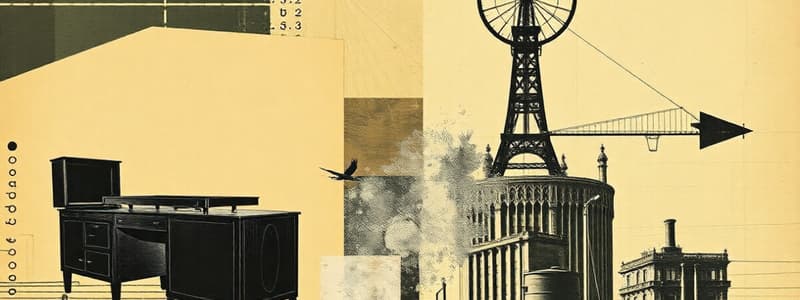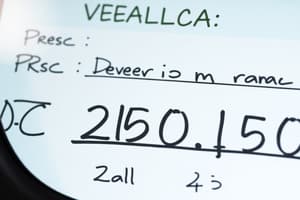Podcast
Questions and Answers
What is the formula for calculating annual depreciation expense using the straight-line depreciation method?
What is the formula for calculating annual depreciation expense using the straight-line depreciation method?
- Cost of Asset / Useful Life of Asset
- (Cost of Asset - Residual Value) / Useful Life of Asset (correct)
- Net Book Value at Start of Year x Depreciation Rate
- Residual Value - Cost of Asset / Useful Life of Asset
Based on a £10,000 asset with a £2,000 residual value and a 5-year useful life, what is the annual depreciation expense using the straight-line method?
Based on a £10,000 asset with a £2,000 residual value and a 5-year useful life, what is the annual depreciation expense using the straight-line method?
- £2,000
- £1,000
- £1,600 (correct)
- £1,200
What differentiates the reducing-balance depreciation method from the straight-line method?
What differentiates the reducing-balance depreciation method from the straight-line method?
- It considers the residual value at the start.
- It applies a fixed percentage to the net book value each year. (correct)
- It results in the same depreciation amount each year.
- It uses the original cost of the asset each year.
If an asset starts with a net book value of £10,000 and has a depreciation rate of 20%, what will be its net book value after the first year?
If an asset starts with a net book value of £10,000 and has a depreciation rate of 20%, what will be its net book value after the first year?
In the reducing-balance method, how does depreciation expense change over the years?
In the reducing-balance method, how does depreciation expense change over the years?
Flashcards
Straight-line Depreciation
Straight-line Depreciation
A method that evenly spreads the cost of an asset over its useful life.
Annual Depreciation Expense
Annual Depreciation Expense
The amount of depreciation recorded each year for an asset.
Reducing-balance depreciation
Reducing-balance depreciation
Depreciation calculated as a fixed percentage of an asset's Net Book Value each year.
Net Book Value
Net Book Value
Signup and view all the flashcards
Depreciation Rate
Depreciation Rate
Signup and view all the flashcards
Study Notes
Depreciation Methods in BTEC Business
- Two common methods for calculating depreciation are straight-line and reducing-balance.
Straight-Line Depreciation
- Simplest and most common method.
- Distributes asset cost evenly over its useful life.
- Formula: (Cost of Asset - Residual Value) / Useful Life
- Cost of Asset: Initial purchase price.
- Residual Value: Estimated value at end of useful life.
- Useful Life: Expected time the asset will be used.
- Example: An asset costing £10,000, with a £2,000 residual value and 5-year useful life, has annual depreciation of £1,600.
Reducing-Balance Depreciation
- Depreciation is a fixed percentage of the asset's net book value each year.
- Results in higher depreciation expenses in early years.
- Formula: Net Book Value at Start of Year × Depreciation Rate
- Net Book Value: Asset's value at start of year, after previous depreciation.
- Depreciation Rate: Fixed percentage set by the business.
- Example: An asset with a £10,000 net book value and a 20% depreciation rate has an annual depreciation of £2,000, reducing the net book value to £8,000 after the first year.
Studying That Suits You
Use AI to generate personalized quizzes and flashcards to suit your learning preferences.




